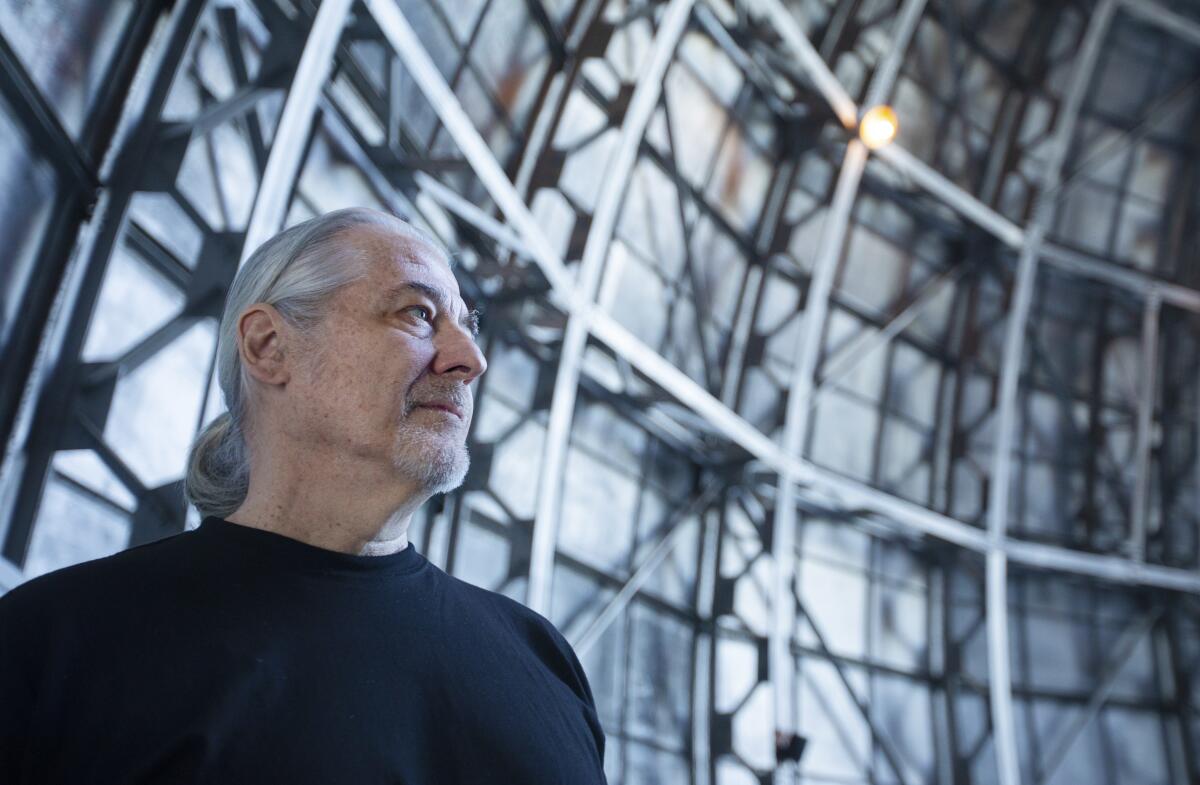At Mt. Wilson, cosmic sound art reaches far beyond a mere moon landing

- Share via
It was still light Friday, the eve of the Apollo moon landing’s 50th anniversary, as I made the slow drive up Angeles Crest Highway onto the local point closest to the stars — physically, optically and preternaturally. When the moon did later come out over the Mt. Wilson Observatory, it was still bright a few days past full but frankly, and oddly, not especially beckoning.
The famed century-old observatory, by my reckoning the single most magical spot in Southern California, put the moon on the map with its stunning early 20th century images of the Earth’s satellite. But the moon that the big 100-inch telescope happened to be directed toward this night was Jupiter’s Europa, a small dot next to the massive planet, which could be viewed during the inauguration of the observatory’s new Cosmic Sounds series.
Meanwhile there was nothing moonstruck about Jeff Talman’s “Of Sound Before the Stars,” which was commissioned by the museum for the occasion. The eight-channel sound installation had both a vaster ambition and more earthbound vision. It served to put the listener in touch with the universe at its very forming and with the iconic dome that houses the 100-inch telescope. Instead, music of otherworldly wonder is made as if for an ancient temple housing a religious icon.
Other moonwalk celebrations, documentaries and remembrances are proud to focus on us humans. We reserve special awe for our ingenuity and industriousness in getting to the moon, turning that into TV for the masses, and leaving behind our footprints, garbage and urine. This is not to dismiss the enormous scientific value of the missions, the worthy (along with the unworthy) enhancements of technology or the mission’s profound enhancement of human imagination. Still, we have on this anniversary a disquieting way of putting us in the center of the universe.
Mt. Wilson, however, retains a healthy sense of history and environment. As a telescope operator meets the audience at the lower parking lot (there is room for only about 40 attendees) and walks up to the dome, he points out where a mountain lion has been seen, as have bears. On the way down late at night he warns us about a particularly mean and dangerous 300-pound deer, making it clear how the astronomers and crew view themselves as visitors. Even this little spot on this little planet in a galaxy that is but an infinitesimal speck in a universe, humans are wise to know their place.
This is where Talman comes in. A New York sound installation artist attracted to cosmic, spiritual and natural spaces, he tunes to the natural frequencies of the environments he encounters. The largest Mt. Wilson dome, with its liquid, cathedral-like acoustics, has metal walls, wooden baffles, a large opening in the roof for the telescope and a pit for the base of the massive instrument sturdy enough to have withstood four major earthquakes over the decades.
Six speakers surround the space, with two more above. Two subwoofers provide knee-vibrating bass. But also like a cathedral, all of that is nothing more than a vehicle for something of greater glory. For Talman captures the original plasma material from which the universe was formed. As he explains it, photons banged around, making sound, their waves instrumental in the formation of matter and ultimately the stars we see in the sky. The sound waves were so long that to hear them we would need ears the size of suns, able to detect pitches more than 50 octaves below the lowest note on the biggest church organ.
With soloist Khatia Buniatishvili, YOLA musicians and John Williams’ “Raiders of the Lost Ark” music, the conductor shows his love for the Bowl. And the Bowl loves him back.
So embedded in today’s cosmic background music, on some massively undetectable level, is the 3.7-billion-year-old data of the original universe soundtrack. A scientist, Mark Whittle, has attempted to make all this audible, and Talman transposed that harmonic information down to the harmonic structure of the place where the telescope focuses on the heavens. Whew!
Someone asked Talman what happens to this new piece, which is 30 minutes long, when it’s not played in the space for which it was created. He answered that it becomes music, like any other music. Talman has made effective binaural recordings of other pieces to be listened to through headphones in which your head seems to expand into its own imposing dome.
Sure enough, on Friday, “Of Sounds Before the Stars” was not music, although it is complexly structured, with lots of interlocking counterpoint, a helping of celestial themes and other components of good composition. I’m sure that all helps, but the experience was different. Harmonics blossomed from deep fundamentals as if stars from the divine hum that made the heavens. Sounds whizzed from speaker to speaker, making the expanding universe incarnate. The sensations of the ear helped the eye make sense of what it saw peering into space.
The Mt. Wilson Observatory plans to bring the installation back next month and in September. The dates have not been worked out, so check the calendar on its website, where you also can find information about the observatory’s intriguing Sunday afternoon chamber music series.
There’s no question that we’ll be back on the moon before long, looking around, gathering data, I hope not making a mess. Everybody is going to want a piece of the action, so my modest suggestion has next to no chance of carrying any weight. Here it is anyway: Include in the space capsule a good quality download of “Of Sound Before the Stars” as part of the astronauts’ cosmic awareness kit.
More to Read
The biggest entertainment stories
Get our big stories about Hollywood, film, television, music, arts, culture and more right in your inbox as soon as they publish.
You may occasionally receive promotional content from the Los Angeles Times.











